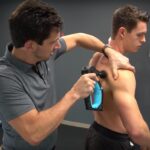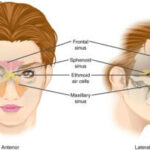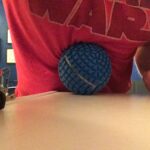Many athletes, especially endurance athletes, suffer from Ilio-Tibial Syndrome (ITBS). ITBS is an inflammation of the Ilio-Tibial band (ITB) at the knee, causing outer knee pain. The causes of ITBS can be varied but the treatment options are usually the same: massage, stretching and strengthening.
What causes ITBS?
The IT band is a fibrous band that runs down the side of the thigh from the hip to below the knee; it goes over a bony prominence at the knee and every time the knee is bent, it rubs against it. Excessive rubbing will eventually irritate the IT band causing inflammation and pain in the outer knee. Excessive rubbing can be caused by:
Overuse/sudden increase in mileage
Morphology: pronated feet (flat feet), bow legs, leg length discrepancy
Running on slanted ground, always in the same direction (eg: running track) Interestingly, the most rubbing occurs at 30 degrees of flexion at footstrike, so for runners, slow speed and downhill running increase the risk of inflammation whereas fast runners and flat surface runners are less at risk.
Poor form or poor bicycle fit.
Tightness from a weak Gluteus Medius – see explanation below.
Although the ITB is not a muscle, several muscles are attached to it at the hip and knee – when these muscles contract, they in turn tighten the ITB. One of these muscles, the Tensor Fascia Latae (TFL), is a small muscle that will “pick up slack” if the Gluteus medius (a hip abductor at the side part of your buttocks) is too weak. By working extra hard to compensate for this weakness, the TFL becomes tight and in turn, the ITB becomes tight. To test your ITB tightness, read reference #6. To test your Hip Abductor strength, read reference #8.
What is the treatment for ITBS?
Acute phase
For the acute phase of IT band pain, the recommended treatment is RICE:
Rest your ITB completely, decrease mileage or temporarily switch to an exercise that doesn’t cause pain (note: when you do get better, get back gradually to your training, it may take a couple of weeks to get back to where you left off)
Ice the painful area for 20min several times a day
Compress the area (a knee brace, for instance)
Elevate your legs to help blood flow return and decrease swelling
After the acute phase
Afterwards, the recommended treatment is usually massage, stretching, strengthening and modifying your posture or environment.
Massage: therapeutic massage therapy will loosen up a tight ITB and participate in the healing process. In-between massage sessions, you should self-massage with a foam roller (see how to do it in the video below).
Stretching: stretching with a therapist will also loosen up the ITB. In-between sessions, self-stretching is recommended (see how to do it in the video below).
Strengthen: strengthen your Gluteus Medius with a Physical therapist or personal trainer. They will give you exercises to do at home. You can view sample exercises in reference #5.
Modifying: this last step requires you to analyze what you’ve been doing to see if there are any factors you can modify in your posture or environment. For instance, as a cyclist, you may want to change your bike fit or cleat position. A runner may need insoles in his/her shoes or may need to change their running route.
As always, make sure to see your physician in case of severe pain or pain that doesn’t go away. They may run some tests to eliminate differential diagnosis and/or offer more treatment options such as cortisone injections or, as a last resort, surgery.
References:
Iliotibial Band Syndrome (ITB Syndrome), ITB Syndrome: Cause, Cure and Your Core, Stephen M. Pribut, D.P.M.: http://www.drpribut.com/sports/spitb.html (viewed on 5/30/14)
Biomechanics of Iliotibial Band Friction Syndrome in Runners, John W. Orchard, MBBS, FACSP, Peter A. Fricker, MBBS, FACSP, Anna T. Abud, BAppSci, Bruce R. Mason, PhD: http://ajs.sagepub.com/content/24/3/375.abstract (viewed on 5/30/14)
Hip Abductor Weakness in Distance Runners with Iliotibial Band Syndrome, Fredericson, Michael MD; Cookingham, Curtis L. MS, PT; Chaudhari, Ajit M. MS; Dowdell, Brian C. MD; Oestreicher, Nina BS; Sahrmann, Shirley A. PhD, PT: http://journals.lww.com/cjsportsmed/Abstract/2000/07000/Hip_Abductor_Weakness_in_Distance_Runners_with.4.aspx (viewed on 5/30/14)
Iliotibial Band Syndrome in Runners, Dr Michael Fredericson, Chuck Wolf: http://link.springer.com/article/10.2165/00007256-200535050-00006#page-1 (viewed on 5/30/14)
Tight IT Band? 3 Simple Exercises to Fix it Now, Michael Choate, M.S., P.T.,http://www.active.com/cycling/articles/tight-it-band-3-simple-exercises-to-fix-it-now?page=2 (viewed on 5/30/14)
Best Stretches for Cycling, The more flexible you are, the faster you can go, with less effort.Take our test to gauge your flexibility—then learn how to loosen up.— Illiotibial (IT) Band Stretch, Kelly Bastone.: http://www.bicycling.com/training-nutrition/training-fitness/illiotibial-it-band-stretch(viewed on 5/30/14)
7. The best damn IT band stretch ever, Brian Reddy: http://b-reddy.org/2012/03/04/the-best-damn-it-band-stretch-ever/ (viewed on 5/30/14)
Hip Exercises: Abductor Strength, Test & Exercise: http://www.sportsmd.com/SportsMD_WatchVideo/vid/335/n/hip_exercises_abductor_strength_test_and_exercise.aspx#sthash.5MNMrftK.dpbs (viewed on 5/30/14)
This article/video is for educational purposes only; do not attempt without your physician’s clearance. If you are in pain or injured, see your physician.
Copyright © Vidal Sports LLC 2018






